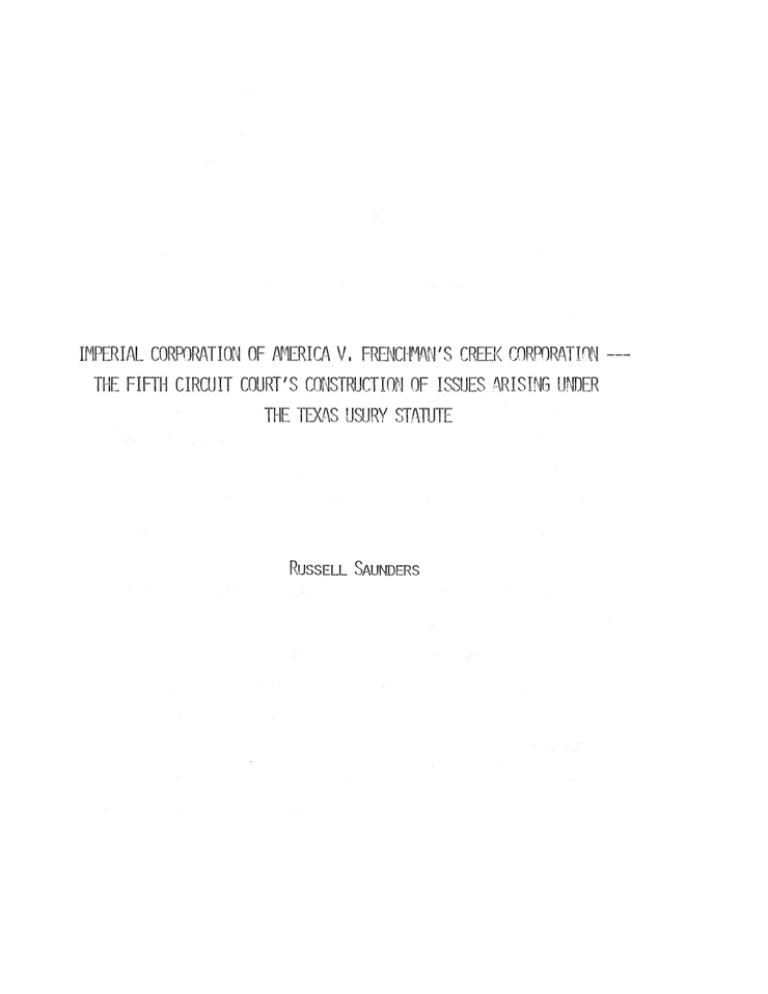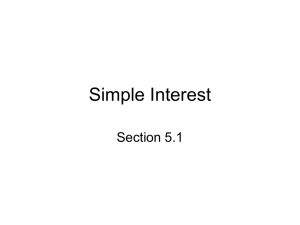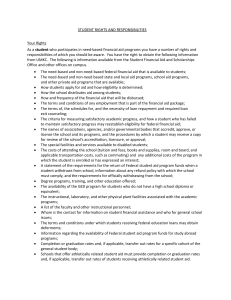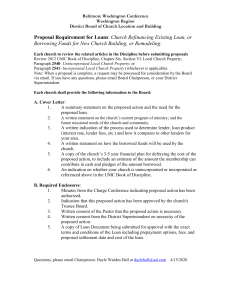IMPERIAL CORPORATION OF Aj' 1ERICA V
advertisement

IMPERIAL CORPORATION OF Aj',1ERICA V FRENCHrvtA.N'S CREEI<
I
THE FIFTH CIRCUIT COURT'S CONSTRUCTION OF ISSUES
THE
TEX~S
USURY STA11JTE
RUSSELL SAUNDERS
CORmR~TInN
:~RISING
UNDER
---
1
IMPERiAL CORPORATION OF AMERICA V'. FRENCHMAN'S CREEK CORPORATION ,- -- THE
FIFTH CIRCUIT ' COURT'S 'CONSTRUCTION OF ISSUES ARISING UNDER THE TEXAS
,
USURY STATUTE.
Frenchman's Creek Corporation borrowed a large sum of money
from Imperial Corporation of America, the interim financier, for the
purpose of building a private
dormitory
near the campus of a Texas
,
,
university. The parties entered into a lengthy and detailed written
Loan Agreement :which specified the terms and conditions governing the
promiSSOry note executed by the Defendant to the Plaintiff, in the
;principa.l 'sum of $4;500,000, with interest payable quarterly on the unpaid balance at 81% per annum from the date of any advancement, of
loan proceeds. The Loan Agreement provided that the note would be
'secured by a 'mortgage and deed of trust 'covering the dormitory
site. The Agreement stipulated that Defendant would reimburse the
Plaintiff for costs,expenses and legal fees, in an amount not to
,exceed $22,500, and would pay a front-end loan or commitment fee of
$67,500 to the Plaintiff. The deed of trust contained a saving clause
and the promissory note contained 'an acceleration clause.
The initial ad~ance was ~ made in the amount 'of $860,000, from
which thE!re waS
deducted the $67;500 commitment feeand '$22,5QO
,
'
,
for ' reimbursement ,of '.the ';a.rorement1.oriedaxpenses. Subsequently,
,
•
I
•
advances we'r e'; ,made U!\,t l1 :theentire '$4; 50()~000 was loaned ,on .tuly 1,
The permanent loan was closed on July 30, 1968. On that same day,
Plaintiff and Defendant executed an amendment ' to their original Loan
Agreement whereby Defendant would pay $4,000,000 principal on thE'!
note and Plaintiff would accept. in renewal and extension of the
$500,000 balance Defendant's note for $500,000, due 1n one year, with
interest at 8;% per annum. Thereafter, Defendant defaulted on the
$500,000 note. Plaintiff sued and Defendant pled usury in defense,
alleging that the interest charged and paid in the loan transaction
exceeded the maximum interest of 10% per annum allowed under the
,
2
,Texas statute. '
The scope of this paper is limited to discussing what I
c~nsider
to be the five central issues raised by the facts of the case and
decided by the courts 1•• Was the $22,500 reimbursement for legal
and other fees "interest" under Texas law? 2. Was the $67,500
front-end commitment fee "interest" under Texas law? 3. What is the
effect, under Texas law. , of a "saving clause" contained in a written
agreement that might otherwise provide for usurious interest? 4.
What is the effect, under Texas law, of an "acceleration clause" conta1ned 1n a wrl,t tert agJ:'eeJitent ' where the wr1 tten agreement also contains
a "sav1ng clause"? ,.5.: What ,1s, ur:tder Texas law, the "11fe of the loan"?
1. In ' the priric'i~l case ttl'a court ' held that "there was ample
evidence ' ~hKt, Imperial ~id :, mon,'~~hai'i , tt)",t :amoun t ($22,500) 1n fees
for ,legal sen ices and
for,;lflS pection ,ot:
the prem1ses as the work
' progressed. Bona ,f~9._~_~fee~ fo~: ~'t!';"Iice8 of this natur~', paid ,to , the
lender's special agents
and~otpartic1pated
",
in by the lender, are
1
,not considered as interest." There is ample authority in the Texas
cases to support the oourt's conclusion. Where the facts show that
the work or service charged for was actually done, and the lender did
not participate in or receive any of the fees charged for such work or
services, such fees are not, as a matter of law, interest under Texas
"It is the law of this state that bona fide fees paid to the
,lender's special agents are not to be considered as interest under
,our usury law, where the lender does not participate in the funds so
,
'
3
,paid ... ,' Nevels v. Harris. "Attorney's fees, inspection and filing fees,
etc., 'a re legitimate service charges and not interest." Mlller v.
,
4
Gibralter Savings and Building Assoc. "A lender may, without
violating the usury "law, make an ' extra charge ,for any distinctly
•
' .
I
separate and additional consideration other ' than the simple lending of
"
,
the money; and where there is any dispute in the
~r1dence
as to whether
,there was any other separate and additional consideration, a question
,
,
5 6
of fact is raised. 11 Greever v. Persky. ,Cf. Dewey v. Amer. Nat. Bank. ,
"Legal fees incurred by lenders and incurred in good faith to an
attorney, where no part of the payment. is received by the lenders, is
not interest in determining whether the loan is usurious •••• When
such expenses are actually incurred and they are paid in good faith ,to
those furnishing the services they are not interest •••• Lenders
must have nodireotbenefit accruing to them ()utof the legal fee."
.
"
7
,
'
Sapphire Homes,",Ince :V. Gilbert . .. "Charges,, made ' to the borrower by the '
,
lender's special agent for special services such as legal work in
preparing documents, inspection of the property to be pledged as
security and attending to the details of clOSing the loan are
'',legi timate charges against the lender and will not taint the contract
8
with usury." Morris v. Miglicco.
2. The court concluded that the $67,500 commitment fee was interest
"by operation of Texas law and not because the parties in their dealings
,
with each other treated it as such." In Deming Investment Co. v. Giddens,
,t he court stated that "it is immaterial how or in what manner or
form the lender of money cloaks a usurious charge for its use or
:,detention, if the result is that such lender, by such means, exacts
'more than the maximum rate of interest, the contract is vitiated with
the taint of usury. The lender may style the ,excessive interest a
bonus or a commission given to him as agent, but if he is in fact
, the lender of the money, and hence acting for himself and not for
another, and receives the bonus ' or commission for the lending of
,his own money, the law denominates such bonus or commission
~,
additional interest.'i
)
In Nevels, supra, the lender took a note for $6,400, but he
did not lend that amount. He,
in,faot,
only loaned $6,lj·oo less $320,
or $6,080. The, $)20 was retained by the lender as a commission fee
for making ,the loan .. The court ' s'peciflca~ly held that , the real amount
of the loan was $6,080 and ' that ; f.he$3?~. ,~~s. ,i !lterest charged on the
, loan.. Where so-called fees or, ~ommiss ions are ' lev,i ed" by ~ lender
aQ:ainst abottowet-
for
dlrect eXJ)enees,' lncurred ' bfthe ,lender" 1n
:the conduct of the :lender'e
own·,i~uflln~~~;,;, a.nd , not"as '~' ~ a.gen~
or 'a
9
broker for a third party who 1s actually supplying the loan proceeds ,
or, where there were no expenses .and the fee or commiss ion is
merely a scheme to avoid the usury statute, all such charges are
interest as a matter of law and are not considered in figuring the
.
10
principal of the loan. Baltimore Trust Co. v. Sanders.
In Eastern Mortgage and. Securities Co.
.
V8 Coll~,
11
borrower
signed a $12,000 note, bearing 6% In:terest, and another note for
$2,400, bearing no interest. Borrower actually received $11,400
from lender. The court found tha.t the payments required to be made
on the second note (for $2,400) was for payment of expenses which
merely represented the overhead eost to lender in conducting its
,money lending business, and were , not notes fo'r expenses legitimately
' ,c hargeable against' the borrowe:-, but were
int~rest
as a matter ,o f . law.
Further, ,the $600 that lender held out of the first note (for
$12,000) was found toconstitut~ interest as a matter of law,
whether it was retained by the lender as commission for lending
its own money, or whether .it was. appUed to ,t he .o verhead cost of
' the lender's business.
Where the facts show that the commission or brokerage fee
was paid to a bona .fide ' agent or broker for services
actually
.
rendered, inneg6tiatlng a loan with athlrd party, the usury laws
. .
.
are not violated. Good faith mus,t be shown and , it must no't appear
tha.t :the fee is part of a mere ,scheme to ' ~void th~ usury , statute~
"It must be' shown , that the loan was ultimately made with or passed
I
"
'.
.
, '..
. .
'
.
•
.
.
faith for negotiating the loan, and Auch · charge may not be made'
where the party charging the commission is merely lending his own
,
' 5
money." Greever, supra. This holding is confirmed in Dewey,
6
supra, wherein the court held thaY'where the broker, who acted
estab~
as the agent for the plaintiff borrower, had no regular or
lished connection with the lender who received none of the finder's
fee paid by the borrower to the broker, payment of the finder's
fee did not taint the loan with usury." The facts showed conclusively that the broker had no regularly established connection
with the lender.
,
12
In Donaghue, v. State, , the court held that charges paid by
a borrower through a ,broker or other third person, as compensation
for services in procuring a loan were not interest in determining
whether the loan was usurious, "but such a relation must be bona
fide, and not merely COlorable for the purpose of concealing
a usurious loan." This holding was noted and approved in Sapphire
1
,
1)
,Homes, Inc., supra. The fact6 and holding of Terry v. Teachworth "
also support ' the above rule. In this case there was a charge in ,the
,
.
.'
.
making of a loan to pay a so-called commission or brokerage fee"
which was paid to, or retained b>"
held that 'the scheme was
noth~ng
the lender himself. The court
but a device for collecting
additional interest, with the result being that the loan was
usurious because the interest
~.ta.tutOry limit of lo%~',
aotual~v , char~ed ,
exceeded th&
.
wherein the court states
t~.at
"general}.y, 'if a lender, or lender'S
agent with the lender'S knowledge or ratification, requires a
borrower to pay a sum of money deSignated a brokerage fee to
lender or lender's agent, such payment will be considered a payment for the use by the borrower of the lender's money; i f the sum
so paid, together with interest paid as provided in the loan contract, exceeds the lawful rate of interest. the contract will be
considered as providing for usurious interest •••• A bona fide fee ·
paid to a broker for, service in procuring a loan is properly
chargeable to the borrower. In subStance, 1t is where the lender
'designates a payment required of the borrowEl!.' as a broke:r:age fee
as a subterfuge to extract from the borrower more than lawful
interest that the contract is usurious."
3• •In the prinCipal case the deed of trust, securing the
lender'S interest in the transaction, had a saving clause providing that "no ,provision of this instrument or of the notes shall
require the. payment or permit the collection of interest in excess
of the maximum permitted by law • .If any excess of interest in such
respect is herein or in the notes provided for, or shall be adjudicated to be so provided for herein or in the notes, the proviaions of this paragraph shall govern, artd neither the Mortgagors
nor their heirs, successors
an~
,assigns shall be obligated to pay
the amount ,of such interest' to' ~he : extent that it is 'in excess of
.the amount· permitted '.hY law.," ;
.
t
,
,"
,
Note the three prll1clpal elentertts bf: th8: ,clause I , 1.; A $pec1flc
•
.
.
"
,
"
.
' .•
;'
.
'
.
'.
',' -, i
.
disclaimer of any intent to require or permit the collection of
usurious ,interest, 2.,.,Provision, for the saving clause to govern
the terms of the instrument should it be det~rmined that the
oIhtr jJ};,.,e-
instrument does, in fact and law'AProvide for usurious interest.
and ).
Obligatin~
the
~orrower
to pay only the maximum l egal
int,e rest provided for 'under the terms of the instrument. The
court noted that "the saving clause cases are but precisely
targeted applications of more general rules of contract construction. The question of whether usury exists is ascertained from '
kthe dominant purpose and intent of the parties embodied in the
contract interpreted as a whole and in the light of attending
circumstances and of ,the governing rUles of law that the parties are
,
"
presumed to have intended to obey," citing ~alker v. Tem1'M Trust Co.
Supporting the saving
, 15
v. Horton,
~lause
~
rationale is Peoria Lif e Ins. Co.
where,1nthe, court stated "that unless the contract
by its express and positive terms evidences an intention which
requires a construction that unearned interest was to be collected
in all events, the court will give it the construction that the
parties intended that the unearned interest should not be collected."
16
Greer v. Franklin Life tns. Co. i holds , that whether or not a loan
transaction , 1,s usurious will be determined by, construing all of: the '
papers executed in ,connection therewith, and not from isolated ,
clauses ,and proviSions' ',t herein. 'Also in agreement ,is Pan American
' ,. ' ,,' ',,',
Life Ins. 00. ' v. '
, ' 17
BoYd~ ,.
,
:w~ich
'
,",. '
't ellS us '" that
~ince
it 'is assumed that
t~e parties :to , aoont.raot . lntend' to obey the 'taw, a ' coUX't will , not hold
.
,
,
.t hat a contract. is usurious ' unless "upon a fair and reasonable
interpretation of all its terms' I'it is manifest that the intention was
to exact usurious interest."
But, note the interest1.ng statement made by . the court in
~,
I)
supra. "Appellants contend that the disclaimer of intent to
charge usurious interest in the
of trust on the property in
~eed
question saves the transaction frOm the taint of usury. But
,appellants cannot 'charge usurious interest · and then escape the '
'penalties by disclaiming an intent to do what they had plainly
done."
Thus, the Texas rule is a reasonable one requiring that the
written agreement between the parties be construed 1n a manner in which
the law 1s not violated, if the .agreement is susceptible of more
.than one construction. The cases ', indicate that where the agreement
plainly provides for ' usurious interest and at the same time merely
~xpresses
an intent not to. violate the usury sta.tute, this will '
not be sufficient to save the agreement from the defense of usury • .
Along with the expression of intent to obey . the law must be a
positive provision to preclude the payment ot usurious interest.
An implication raised by the disciaimer of intent is not enough.
The agreement Should contain a provision, as in the principal case, .
wherein
the obligor' is specifically excused
from pay1ne· any usurious
.
.
,
.interest .under the 'terms of~hea.greement. ·
The .bes.t way ·,t:o :p~.tect ; aga.1nst ..th~ . :co~ti~gencyof subs,equent
. .
.
f~
.
'. ,
If
,I
I
,.
... "
,'
,
.
',,'
t .·
• .
,.'
judicially determined usury is to have a saving clause providing
,therein tha.t the say ing clause shan ,;,govern the other terms of
the agreement, disclaiming an intent to exact usurious interest
' .
~ At\.'I J,J::J
and reUeving the obUgor to pay any interest abOve the maximum'
A
legal rate.
4. The Texas cases dealing with instruments containing an
acceleration clause and a saving c,lause ' are consistent with the
reasoning of the saving clause cases. When there is an instrument
containing an acceleration clause and a saving clause the expression
, of the intent of the parties in the saving clause will be given
effect whenever poss i ble, <' and;'unless !acce lera. tion actually occurs,
the loan will be upheld as non-usurious.
In the principal case the note contained an acceleration clause.
The trial court found that if default and acceleration had occurred
during the first twelve months usurious interest would have resulted.
The s8.vingclause was held t~ prevent this contingency from giving '
rise to usurious interest where acceleration, did not occur. The "
"life of the loan" issue is raised here. However, it will 'be discussed
separately, below.
In Shropshire v. Commerce Farm Cred! t Co.,
18
both the note and the
deed of trust' provided that i f default 'was' made in the payment ,o f
any instalime'n t when, due, then,at the n'ote';'holder's option, "the
same' wl,t h' interest and 'all' other indebtedness' and charges secured
h,erebys,h8;l"t, !,ttl th6U~ ' n,o~lc~~ become due ' ; an~ :ipaYable.,t' The oourt
held that under these clauses the amount of interest collectible
,upon the acceleration of maturity would have exceeded the legal
,maximum of
1Q~
per annum on the amount loaned. There was no
,provision for collecting only the amount of interest actually
'earned up to the time acceleration might occur, nor was there a
saving clause.
Thus,
t~a:,: credlto:r.·s ~
past, unexercised option to accelerate
maturity upon the borrowers default will make a transaction usurious
if the contract terms would have ' called for default payments in
~xcess
of principal plus 10% interest." But, a saving clause will
prevent such a conclusion so long as acceleration has not actually
occurred.
, Supporting the rationale of' the two-clause cases are cases such
14
as Walker, supra, wherein the loan was evidenced by a series of
notes secured by a deed of trust containing literal words of
acceleration susceptible of being construed to provide for the
collection of unearned interest. But, it was held that the contract as
a whole clearly manifested the parties' intention to avoid the
collection of any usurious interest. See Peoria Life Ins. Co.
15
supra,
where the transaction in that case was held n?t usurious, again,
where the contract: as ' a :whole manifested the intention to avoid the
• •
'
'
"
I
~
.,".
:
"
. • • J.,.
•
".\.
:ooliection of usurious
interest.
.
"
~
'
In
Ne'veis~:3supra.,an arguement waS
made that since the note cont&in-
,~d ' pro,vls1oltS.i 'wt\~dh~ 'll~c)¥e,d \tt1~hd,~d~r:i 1s.t"'hii!:: , opt.lon' to mature it at
the end of each year for nonpayment, the contract was usurious.
The court rejected the arguement not only because the express provisions of the contract provided that the unearned interest notes
would be cancelled, if the holder exercised his option under the acceleration provisions, but also because of the saving clause provision
in the deed of trust stating 'fthat"the intention of the parties
'being to conform strictly to t.he Usury Laws now in
fOT.ce~
any of said
contracts for interest shall he held to gesubject to reduction to
the amount allowed under the Usury Laws as now or hereafter construed
by the courts having jurisdicti0i'1." ' The, ; Nevel~3: holdd.ng' was; noted.'and
, 17 '
followed in Pan American Life Ins. Co., supra.
A good summary of the Texas rule is found in the case of
Sinclair v. Mack Trucks, Inc.
19
The court said "that unless the contract
by its express and positive terms evidences an intention which requires a oonstructionthat unearned interest was to be collected in
all events, the court will give ,it the construction that the parties
intended that 't he unearned interest should not be collected.", Such ,
an intent is easy to find where the instrument containing the
acceleration clause also contains a saving clause.
5. The question
,of usury ' .is
' genera,l ly one r of fact. The central
,
, .
~
'
..
conSideration in answering that,l:question is to determine the "Ufe
of the loan.'!. The time~l:'iod ',ol ,the' loa'n; ~ the central factual issue,
will , det~rmlne,;, the ,..u~,~rl"us ::.1nt~l\est. ,ql,1estlpn",in case's , where usury
is not,,clea.riY' shoWn dh" th~ fao~ ,of the tW1't tltn 1.nstrument(s l.'
J
The "life of the loan" issue was present in Nevels, supra.
The court said that the questiDn is whether or not the interest
to be paid is greater than "10% per annum from the time the borrower
had the use of the money until he should repay it." In the
prinoipal case the court emphasized the phrase "until he should
repay it," in holding that the due date of the renewal and extension note (the $500,000 note) was the termination date for the
life of that loan.
Another element of the nlife of, the loan" issue announced in
.
J
Nevels, supra, and followed in the principal case is that all of the
instruments executed in connection with the loan transaction must
be treated together as constituting the agreements between the
parties where the defense of usury is raised.
So, in the
princlpal ~case
the life of the loan was held to
have commenced either on the date of the Signing of the original
Loan Agreement or on the date of the initial advance of loan
proceeds, and to have terminated on the due date of the renewal
and extension note. The interest, including the front-end commitment
. fee, spread over the entire period of the life of the loan did
. not exceed
10% per annum.
CITATIONS
1. 453 F.2d 13)8 (5th Cir. 1972), reh. den.
2. Tex. Rev. Civ. Stat. Ann., Art. 5069-1.02.
3.102 S.W.2d 1046 (Tex. 1937).
4. 132 S.W.2d 606 (Tex. Civ. App. 1939), reh. den.
5. 165 S.W.2d 709 (Tex. 1942), rehe den.
6. 382 S.W.2d 524 {Tex. Civ. App. 1964)g reh. den., writ ref 0, n.r.e ..
7. 426 S.W.2d 278 (Tex. Civ. App. 1968) /I reh. den., writ ref., n.r.e.
8. 468 S.W.2d 517 (Tex. Civ. App. 197 1), reh. den., writ ref., n.r.e.
9. 41 S.W.2d 260 (Tex. Civ. App. 1931), reh. den.
10. t05 S.W.2d 710 (Tex. Civ. App. 1937) , reh. den.
11. 118 S.W .2d 479 (Tex. Civ. App. 1938), reh. den.
12. 211 S.W.2d 623 (Tex., Civ. App. 1948), reh. den., writ ref., n.r.e ..
13. 43 1 S.W.2d 9 18 (Tex. Civ. App. 1968) , reh. den., writ ref., n.r.e.
14. 80 S.W.2d 935 (Tex. Comma App. 1935).
15. 84 S.W.2d 864 (Tex. Civ .. App. 1935), reh. den ..
16. 109 S.W.2d 305 (Tex. Civ. App. 1937) , reh. den.
17. 124 S.W.2d 917 (Tex. Civ. App. 1939), reh .. den ..
18. 30' S.W.2d 282 (Tex. 1930), aff'd on reh., 39 ~.W.2d 11, cert. den., 284 U.S. 675.
19. 35'5 S.W.2d 563 (Tex. Civ. App. 1962), reh. den., writ ref., n.r .. e.





